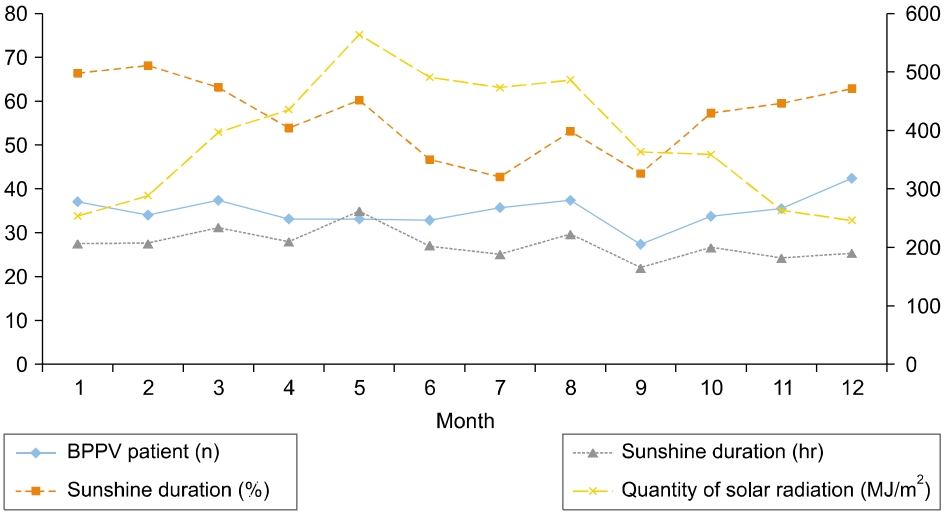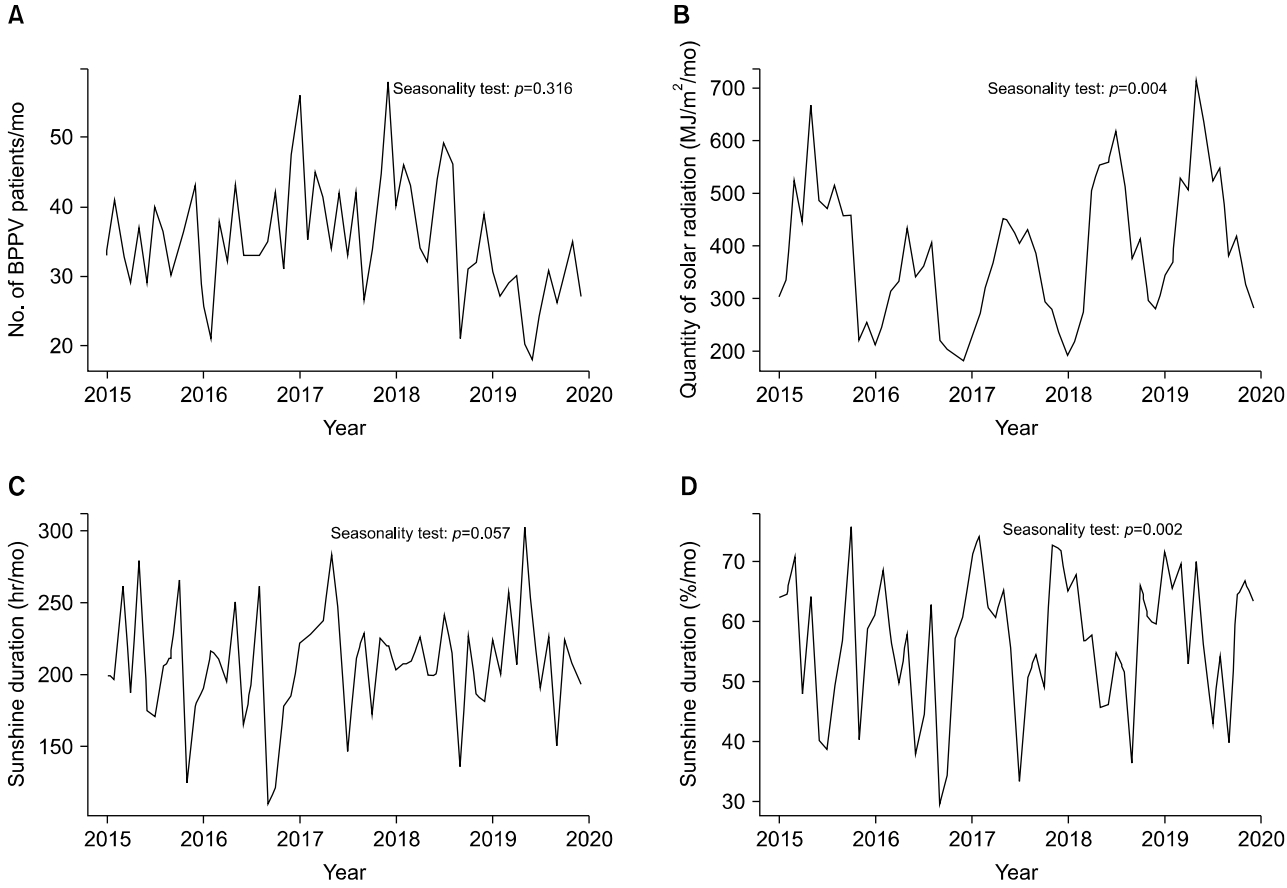Articles
- Page Path
- HOME > Res Vestib Sci > Volume 19(3); 2020 > Article
-
Original Article
양성돌발두위현훈의 연중 발생 분포와 기후인자의 주기적 변동 -
임채동1, 조기주2, 이현진3, 허동구3, 김록범4, 안성기1,5

- The Periodic Fluctuation of Intra-Annual Distribution of Benign Paroxysmal Positional Vertigo and Meteorological Parameters
-
Chae Dong Yim1, Ki Ju Cho2, Hyun Jin Lee3, Dong Gu Hur3, Rock-Bum Kim4, Seong-Ki Ahn1,5

-
Research in Vestibular Science 2020;19(3):99-103.
DOI: https://doi.org/10.21790/rvs.2020.19.3.99
Published online: September 15, 2020
1Department of Otorhinolaryngology-Head and Neck Surgery, Gyeongsang National University Hospital, Gyeongsang National University College of Medicine, Jinju, Korea
2Department of Otorhinolaryngology-Head and Neck Surgery, Asan Medical Center, Seoul, Korea
3Department of Otorhinolaryngology-Head and Neck Surgery, Gyeongsang National University Changwon Hospital, Gyeongsang National University College of Medicine, Changwon, Korea
4Department of Preventive Medicine, Gyeongsang National University Hospital, Gyeongsang National University College of Medicine, Jinju, Korea
5Institute of Health Sciences, Gyeongsang National University, Jinju, Korea
- Corresponding Author: Seong-Ki Ahn Department of Otorhinolaryngology-Head and Neck Surgery, Gyeongsang National University Hospital, Gyeongsang National University College of Medicine, 79 Gangnam-ro, Jinju 52727, Korea Tel: +82-55-750-8178 Fax: +82-55-759-0613 E-mail: skahn@gnu.ac.kr
Copyright © 2020 by The Korean Balance Society. All rights reserved.
This is an open access article distributed under the terms of the Creative Commons Attribution Non-Commercial License (http://creativecommons.org/licenses/by-nc/4.0) which permits unrestricted non-commercial use, distribution, and reproduction in any medium, provided the original work is properly cited.
- 4,058 Views
- 70 Download
Abstract
-
Objectives:
- The influence of specific meteorological conditions, such as solar radiation quantity, duration of sunshine, and their covariation on the incidence of benign paroxysmal positional vertigo (BPPV) has been rarely investigated. Aiming at better predictions of the monthly variation of BPPV, we investigated variations in the monthly incidence of BPPV patients and meteorological parameters.
-
Methods:
- A total of 2,111 patients who had been diagnosed with BPPV at one institution were analyzed retrospectively. Monthly counts of BPPV patients were analyzed for incidence distributions throughout the 5 years. The relationship between intra-annual distribution of BPPV and meteorological parameters was compared by the time series analysis.
-
Results:
- The lowest monthly incidence of BPPV patients was found in September and the highest monthly incidence was found in December. Statistically, as a result of the time series analysis, a periodic fluctuation of both quantity of solar radiation (p=0.004) and percentage of sunshine duration (p=0.002) was identified, but a periodic fluctuation of both number of BPPV patients (p=0.316) and sunshine duration (p=0.057) was not identified.
-
Conclusions:
- Unlike previous studies, the results of time series analysis did not confirm that there is a periodic fluctuation in the incidence of BPPV patients. The incidence of BPPV may be more affected by other factors than by meteorological parameters.
서 론
대상 및 방법
결 과
고 찰
결 론


- 1. von Brevern M, Radtke A, Lezius F, Feldmann M, Ziese T, Lempert T, et al. Epidemiology of benign paroxysmal positional vertigo: a population based study. J Neurol Neurosurg Psychiatry 2007;78:710–5.ArticlePubMed
- 2. Kim JS, Zee DS. Clinical practice. Benign paroxysmal positional vertigo. N Engl J Med 2014;370:1138–47.ArticlePubMed
- 3. Hall SF, Ruby RR, McClure JA. The mechanics of benign paroxysmal vertigo. J Otolaryngol 1979;8:151–8.PubMed
- 4. Yamanaka T, Shirota S, Sawai Y, Murai T, Fujita N, Hosoi H. Osteoporosis as a risk factor for the recurrence of benign paroxysmal positional vertigo. Laryngoscope 2013;123:2813–6.ArticlePubMed
- 5. Jeong SH, Kim JS, Shin JW, Kim S, Lee H, Lee AY, et al. Decreased serum vitamin D in idiopathic benign paroxysmal positional vertigo. J Neurol 2013;260:832–8.ArticlePubMedPDF
- 6. Celikbilek A, Gencer ZK, Saydam L, Zararsiz G, Tanik N, Ozkiris M. Serum uric acid levels correlate with benign paroxysmal positional vertigo. Eur J Neurol 2014;21:79–85.ArticlePubMed
- 7. Yang H, Gu H, Sun W, Li Y, Wu H, Burnee M, et al. Estradiol deficiency is a risk factor for idiopathic benign paroxysmal positional vertigo in postmenopausal female patients. Laryngoscope 2018;128:948–53.ArticlePubMed
- 8. Whitman GT, Baloh RW. Seasonality of benign paroxysmal positional vertigo. JAMA Otolaryngol Head Neck Surg 2015;141:188–9.ArticlePubMed
- 9. Saeed BMN, Omari AF. Climatic variations and benign paroxysmal positional vertigo. J Otol 2016;11:33–7.ArticlePubMedPMC
- 10. Meghji S, Murphy D, Nunney I, Phillips JS. The seasonal variation of benign paroxysmal positional vertigo. Otol Neurotol 2017;38:1315–8.ArticlePubMed
- 11. Shu L, Wu J, Jiang CY, Sun XH, Pan H, Fang J, et al. Seasonal variation of idiopathic benign paroxysmal positional vertigo correlates with serum 25-hydroxyvitamin D levels: a six-year registry study in Shanghai, China. Sci Rep 2019;9:16230. ArticlePubMedPMCPDF
- 12. Wacker M, Holick MF. Sunlight and vitamin D: a global perspective for health. Dermatoendocrinol 2013;5:51–108.ArticlePubMedPMC
REFERENCES
Figure & Data
References
Citations

- Figure
- We recommend
- Related articles
-
- Clinical Characteristics of Benign Paroxysmal Positional Vertigo Positive on Bilateral Dix-Hallpike Test
- Treatment in Benign Paroxysmal Positional Vertigo: Factors that Affect Successful Treatment Outcome
- Auto-Pattern Recognition for Diagnosis in Benign Paroxysmal Positional Vertigo Using Principal Component Analysis: A Preliminary Study
- Clinical Characteristics of Recurrent Benign Paroxysmal Positional Vertigo: A Retrospective Cohort Study
- Intravenous Zoledronic Acid in Elderly Patients with Benign Paroxysmal Positional Vertigo and Osteoporosis

 KBS
KBS
 PubReader
PubReader ePub Link
ePub Link Cite
Cite



